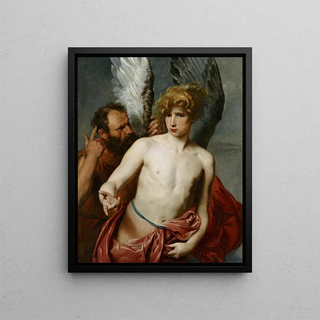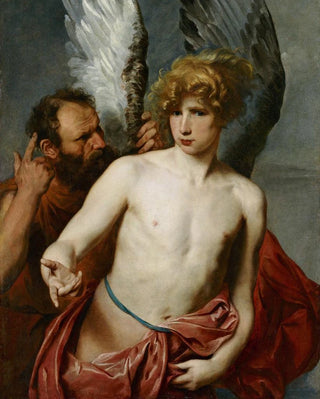Art print | Dédale et Icare - Antoine van Dyck


View from behind

Frame (optional)
Antoine van Dyck's "Daedalus and Icarus" art print is a poignant illustration of an ancient myth, where tragedy and beauty intertwine. This painting, rich in emotion, immerses us in the complex universe of family relationships and human ambitions. The scene depicts Daedalus, the inventor of the famous wax wings, warning his son Icarus of the dangers of pride. This portrayal, both dramatic and touching, evokes universal themes such as disobedience, the quest for freedom, and the consequences of our choices. Van Dyck's technical mastery allows the viewer to feel the palpable tension between father and son, while offering a reflection on the fragility of existence.
Style and uniqueness of the art print
Van Dyck's style is characterized by his masterful use of light and shadow, a technique that gives a striking depth to his compositions. In "Daedalus and Icarus," warm colors and meticulous details create an immersive atmosphere, inviting the observer to contemplate the emotions of the characters. Facial expressions, carefully crafted, demonstrate the artist's virtuosity, capable of capturing complex feelings with such finesse. Moreover, the dynamic between the figures, where Daedalus appears both protective and desperate, enhances the uniqueness of this art print. The composition, balanced and harmonious, guides the eye across the canvas, gradually revealing the depth of the family drama at play.
The artist and his influence
Antoine van Dyck, a pupil of Rubens, marked art history with his baroque style and his ability to combine realism and idealization. His career, which took him from Flanders to the English court, testifies to his immense talent and lasting influence on European painting. Van Dyck breathed new life into portraits, giving them an unprecedented psychological dimension. His approach to the subject, where an emotional connection with the characters is felt, has inspired many artists through the centuries. The depiction of myths and historical narratives, as in "Daedalus and Icarus," demonstrates

Matte finish

View from behind

Frame (optional)
Antoine van Dyck's "Daedalus and Icarus" art print is a poignant illustration of an ancient myth, where tragedy and beauty intertwine. This painting, rich in emotion, immerses us in the complex universe of family relationships and human ambitions. The scene depicts Daedalus, the inventor of the famous wax wings, warning his son Icarus of the dangers of pride. This portrayal, both dramatic and touching, evokes universal themes such as disobedience, the quest for freedom, and the consequences of our choices. Van Dyck's technical mastery allows the viewer to feel the palpable tension between father and son, while offering a reflection on the fragility of existence.
Style and uniqueness of the art print
Van Dyck's style is characterized by his masterful use of light and shadow, a technique that gives a striking depth to his compositions. In "Daedalus and Icarus," warm colors and meticulous details create an immersive atmosphere, inviting the observer to contemplate the emotions of the characters. Facial expressions, carefully crafted, demonstrate the artist's virtuosity, capable of capturing complex feelings with such finesse. Moreover, the dynamic between the figures, where Daedalus appears both protective and desperate, enhances the uniqueness of this art print. The composition, balanced and harmonious, guides the eye across the canvas, gradually revealing the depth of the family drama at play.
The artist and his influence
Antoine van Dyck, a pupil of Rubens, marked art history with his baroque style and his ability to combine realism and idealization. His career, which took him from Flanders to the English court, testifies to his immense talent and lasting influence on European painting. Van Dyck breathed new life into portraits, giving them an unprecedented psychological dimension. His approach to the subject, where an emotional connection with the characters is felt, has inspired many artists through the centuries. The depiction of myths and historical narratives, as in "Daedalus and Icarus," demonstrates






